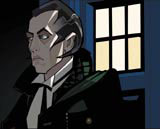Screen grabbing
Cosgrove Hall bought us DangerMouse, but it’s time for a new ‘webisode’ in computer animation, says Nick Smurthwaite

The chances of Britain producing its own home-grown Finding Nemo may be slim, but when it comes to animation for television we are firmly in the premier league. This is largely due to the Manchester-based Cosgrove Hall, a powerhouse of creativity for nearly three decades, maker of DangerMouse, Count Duckula, Rotten Ralph, Oakie Doke, Foxbusters, Albie, the new-look Bill and Ben and, most recently, Engie Benjy, which seems to have taken over where Bob the Builder left off.
Its programmes sell to more than 80 overseas markets and it is regularly featured in Top Ten Children’s Video lists.
The latest Cosgrove Hall production is an on-line Dr Who adventure, The Scream of the Shalka, to coincide with the veteran time traveller’s 40th anniversary.
It took producer-director Steve Maher just five months to complete, which must be something of a record for an 80-minute animation when you consider that Finding Nemo took around four years.
Using a combination of line drawing, computer-generated imagery and flash animation, Maher was spurred on by the voice talents of Richard E Grant as the doctor, and Sophie Okenedo as his sidekick.
‘Flash has a reputation for being simplistic because it is used a lot for designing websites,’ says Maher, ‘but if you know what you’re doing it’s an extremely useful tool for animation.
‘Because a lot of animators now use all the options at their disposal, you have to make sure it’s not too obvious when you are using CGI. It has to look seamless. In the end, CGI is a tool, like Flash, and it shouldn’t dictate the look of the finished animation.’
Maher was also art director on Albie for CITV, about a little boy whose imaginary friends are animals, which has won six international awards since it was launched in 2002, and has just been nominated yet again in the Children’s Baftas.
‘It was a steep learning curve for all of us working on Albie, trying to combine CGI with drawn animation,’ he says. ‘I wanted to use CGI to serve the loose, scribbly look of Andy Cutbill’s original illustrations.’
While not the be-all and end-all, clearly CGI enables the creatives at Cosgrove Hall to achieve effects that make their cartoons more believable to the (mostly) young viewers.
As with a lot of Cosgrove Hall’s animated series for the pre-school market, models are used in the very popular Engie Benjy – a second series of 26 has just gone into production – but the colourful and busy world surrounding the characters is created entirely by the magic of CGI.
What distinguishes Cosgrove Hall and, say, Aardman Animations, is its diversity, which embraces everything from Andy Pandy to The In-Breds, an adult cartoon series sending up in-bred family life in the southern states of the US. It has also just completed a three-minute pop video for a rap singer called Red Rat, which combines live action with animation featuring the popular 1970s character DangerMouse. ‘We like playing around and trying new things,’ explains creative director Ben Turner. ‘It is a very youthful workforce with a lot of ideas. We also believe in training the right kind of people inside the company and extending skills in all directions. A traditional drawn or stop-motion animator who is interested in working in CGI can be given training to move into that discipline. That way, people can learn at their own speed.’
Is it beyond the realms of possibility for Cosgrove Hall that it might one day produce a full-length feature along the lines of blockbuster animations Finding Nemo or Ice Age?
‘It would be almost impossible for us to get our hands on that kind of money,’ says Turner, ‘because the British market is too small. We have the creative skills in this country to do it, but you would have to be far better equipped than we are. Pixar, which made Finding Nemo, has a lot of highly specialised, bespoke software, not to mention the might of the Disney empire behind it.’
Maher says, ‘The whole ethos of Cosgrove Hall is that the producers work in all areas. New technology has blurred the edges of who does what. The technical skills are the same for each job you do. What’s important and individual to each project is the storytelling and the creative input.’
Doctor Who – The Scream of the Shalka shows at www.bbc.co.uk/ cult/doctorwho from 13 November
-
Post a comment



